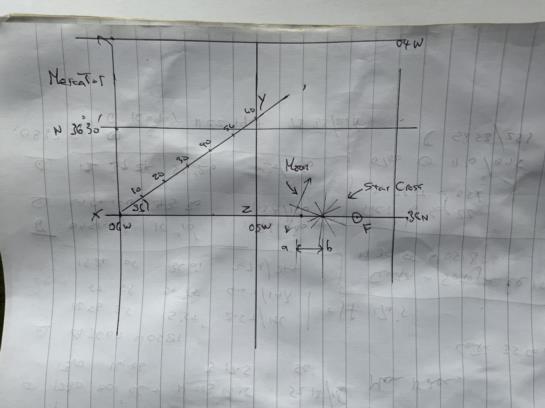
NavList:
A Community Devoted to the Preservation and Practice of Celestial Navigation and Other Methods of Traditional Wayfinding
From: Brian Walton
Date: 2022 Oct 15, 07:36 -0700
On a recent trip, I found the moon available at morning star time. If the moon is within about 30° of the east/west line (Prime Meridian) here is a suggested way of checking time.
I always plot fixes and distance run on a spiral bound exercise book, also used as my log book. This involves constructing a Mercator chart for the nearest Lat/Long using a protractor and dividers, as shown. You can do this in the cockpit, or lying in your bunk. No universal chart.
It can be said that:
a. If under short-handed small sailing boat ocean conditions, moon and star PLs usually cross fairly tightly, the watch is good. No further action. 5 miles OK; 10 miles, take another look.
b. If a split in longitude occurs between the star cross, and the moon PL, there is an error in time, and thus longitude.
Use whatever way you prefer to get intercept and azimuth. I prefer DR to AP, since. plotting is simpler. It doesn't matter where your DR is, but it results in a star cross, and a moon PL, which maybe misses the star cross. By way of illustration, suppose the morning stars cross at a Lat of 36°N, and the moon PL is as shown. This gives a plot as shown. The construction XYZ triangle is already there. Proceed as follows:
1. Measure with dividers, the difference in Long (a to b)
2. Transfer the dividers to the miles scale, to get this distance in miles, in this case 11 miles.
3. Multiply by 4, 4x11=44. This is the time error at the equator.
4 . Set your dividers to 44 on the scale XY, rotate about the X point down to the XZ line(Lat), and read straight up to the scale to get 55. Your time error at this Lat is 55 seconds.
You have a watch error of 55", and a Long difference of 11 miles. It needs to be decided if the watch is fast, or slow, and if the star cross should be moved east or west.
Some mnemonics might help. RAF. If the moon is Rising, ( in the morning) and the PL is Away, the watch is Fast. RAF. SAS. If the moon is Setting, ( in the evening) and the PL is Away, the watch is Slow. SAS.
Which way should you move the cross fix? Watch sloW, move it West. Watch fast, move it East. Just set your dividers at (a to b), and move away from the moon PL, from the old star cross, to make a new fix at F.
There will still be a small error due to the moon moving slowly east relative to the stars, but your watch and fix will be better than they were. Within 5 miles, is OK.
CN is just an aid. This is only another tool in the box, to be used if you need it. All done, in less than a minute, lying in the bunk.
Written, lying in the bunk, in my boat.







